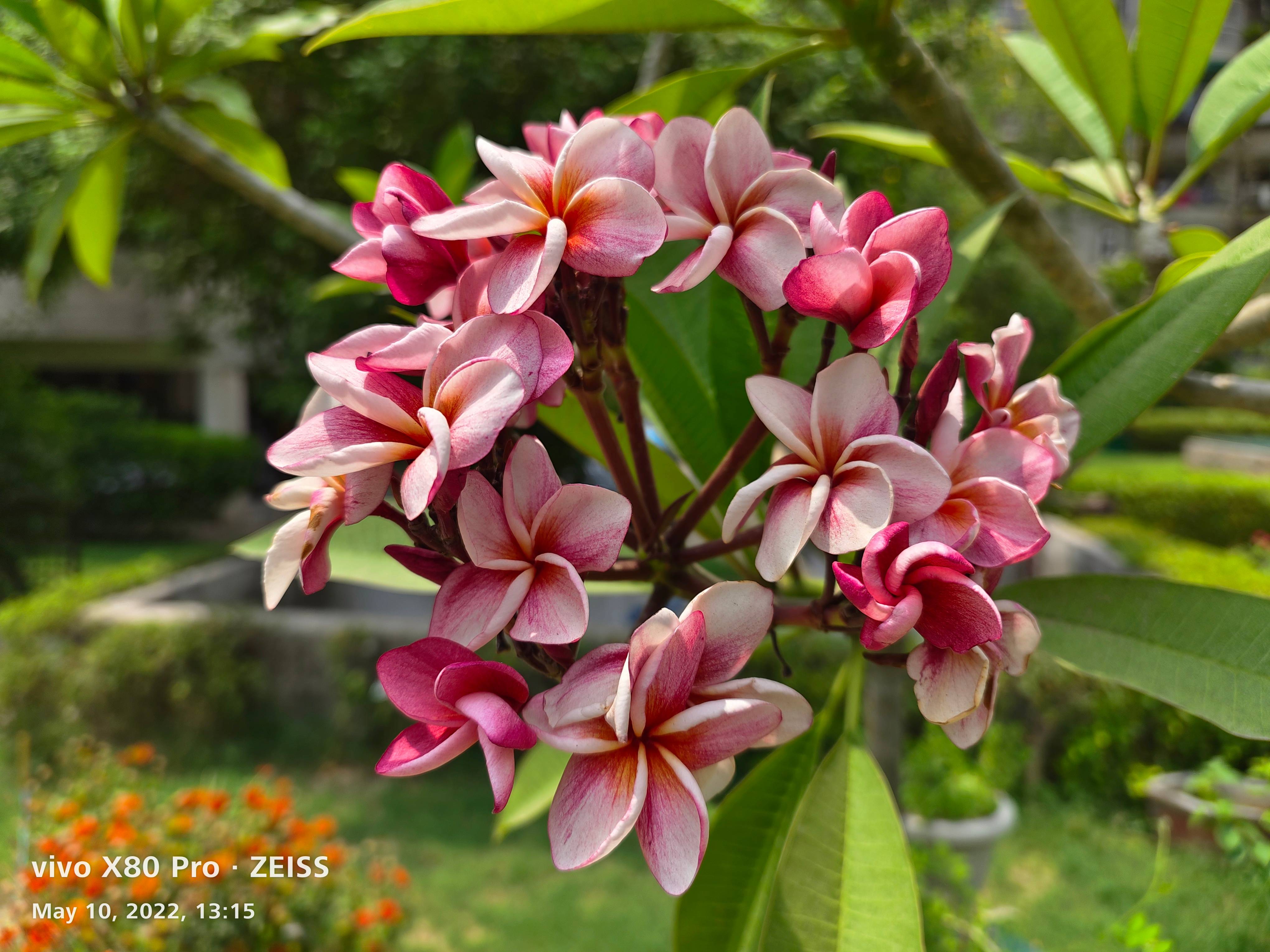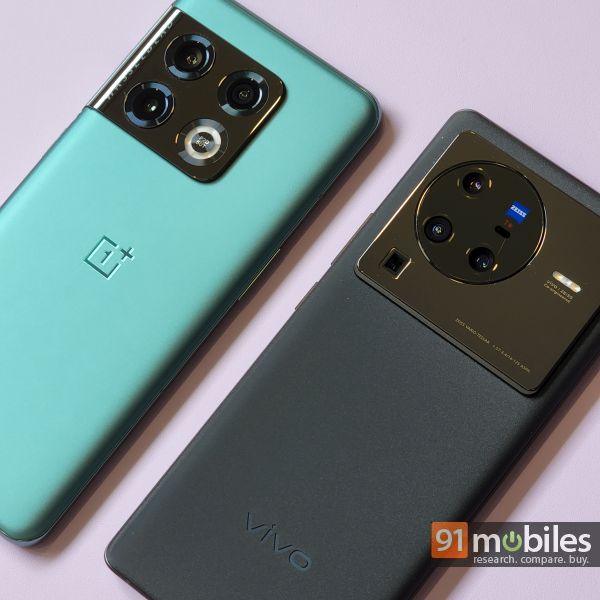
Off late, there has been an influx of premium Android phones that feature excellent camera arrays, allowing users to take stunning images in a variety of scenarios. Needless to say, buyers looking for a high-end Android are spoilt for choices. However, Vivo hopes to make your buying decision that much trickier with its all-new X80 series of smartphones. The Vivo X80 Pro, in particular, features an impressive quad-camera stack comprising a 50MP custom sensor and a 5x telephoto lens. This begs the question – can the device go toe-to-toe with some of the best camera phones in the market, the likes of which include the OnePlus 10 Pro (review)? Well, let’s find out, shall we?
Camera specs
First and foremost, let’s take a closer look at our contenders’ camera specs. To wit, the Vivo X80 Pro ships with a quad-camera setup at the back comprising a 50MP Samsung GNV primary sensor that works alongside a 48MP Sony IMX598 ultra-wide unit, a 12MP 2x portrait sensor and an 8MP 5x periscope lens.
The OnePlus 10 Pro, on the other hand, utilises a triple camera array at the back comprising a 48MP Sony IMX789 sensor, a 50MP Samsung JN1 ultrawide angle lens and an 8MP telephoto sensor with 3.3x optical zoom capabilities. For selfies, the devices get a 32MP sensor upfront.
Daylight HDR
Let’s kick things off by comparing the shots taken from our contenders’ primary sensors under the sun. Here, more often than not, the OnePlus 10 Pro would yield a more detail-laden image with better corner sharpness. That said, the OnePlus 10 Pro’s colour science isn’t as natural as the brand would like you to believe. In fact, the Vivo X80 Pro clicks more authentic photos with the Zeiss mode enabled.


Now, a picture is worth a thousand words so, let’s break down my findings with the help of the slider attached above. Right off the bat, you’ll notice that with the Zeiss mode disabled, the Vivo X80 Pro clicks extremely punchy photos and the smartphone spruces up the vibrancy of the leaves by quite a bit. In contrast, the OnePlus 10 Pro’s photo appears more natural. Furthermore, at a closer crop, you’ll observe that the tree with the number ‘8′ etched on its bark offers significantly better details in the 10 Pro’s composition. In fact, the Vivo X80 Pro has completely glossed over the texture of the bark and has rendered the shrubs surrounding it rather poorly too.


To the phone’s credit, the X80 Pro can mimic the colours of a scene to a tee by utilising the Zeiss mode. For instance, in the slider attached above, the X80 Pro’s image appears overtly saturated and the device has enhanced the blues and the greens in the snap by quite a lot.


That said, with the Zeiss mode enabled, the smartphone outputs a more realistic image that draws a lot of parallels to the photo snapped by the OnePlus 10 Pro. In fact, the X80 Pro one-ups the 10 Pro by rendering various elements more tastefully too. Case in point, the blue and green bins, which look somewhat doctored in OnePlus’ snap. Similarly, the flower pots appear redder in the 10 Pro’s photo too. Heck, even the mud near the sidewalk has a reddish tinge to it in the OnePlus 10 Pro’s snap. The X80 Pro rectifies the aforementioned niggles and out-turns a truer-to-life scene. Be that as it may, the corner sharpness is still better in the OnePlus 10 Pro’s photo.


Here’s another example which substantiates my findings further. In the slider attached above, the OnePlus 10 Pro’s image exhibits better sharpness around the edges of the frame. The same is evident if you look at the trees in the background or the walls of the guard room towards the left-hand side of the composition. That said, the 10 Pro struggles with realizing the red hue of the fire tank properly. The Vivo X80 Pro, on the other hand, outputs a more realistic scene that brings out the rustic texture of the signage board admirably. That said, you can better the output tenfold by switching over to the Zeiss mode wherein, the smartphone renders the shade all that more astutely.
Human Subjects
It goes without saying that buyers eyeing the two phones will click oodles of photos of their peers. On that note, the Vivo X80 Pro is more skilful at clicking photos involving human subjects, primarily because the device renders the subject’s skin tone more accurately. I also noticed that the handset created a more convincing bokeh effect around the subject’s frame.


As an example, if you look at the slider attached above then here, you’ll notice that my colleague’s skin tone appears more natural in the X80 Pro’s snap. In contrast, the OnePlus 10 Pro has added an orangish tinge to the image. Furthermore, I noticed that the X80 Pro kept instances of highlight clipping at bay too. In fact, you’ll notice overexposed bits around the subject’s face in the 10 Pro’s shot. And, at a closer crop, the X80 Pro’s bokeh appears slightly better too and the blur effect wraps around the subject’s ear admirably in Vivo’s snap.
Zoom
Both the Vivo X80 Pro as well as the OnePlus 10 Pro ship with a dedicated 8MP telephoto sensor. That said, the X80 Pro features a 5x optical zoom camera, whereas the OnePlus 10 Pro utilises a 3.3x optical zoom sensor. Now, truth be told, I wasn’t sold on the output from either of the two sensors. However, if I had to pick one over the other, I would opt for the one on the X80 Pro.


For one, the X80 Pro can match the sharpness offered by the 10 Pro at a 3.3x crop. In fact, in the slider attached above, the leaves of the trees, as well as the airconditioning unit appear equally sharp and structured in both the photos. However, the OnePlus 10 Pro’s image quality takes a steep dip as you climb up the zoom ladder.


Case in point, the 5x shot of two bikes in my apartment complex. Here, you can clearly tell that the 10 Pro’s image is inferior to the X80 Pro’s snap and the photo is flush with noise. The X80 Pro’s snap, on the flip side, isn’t remotely as grainy as the 10 Pro’s image.


Similarly, the 5x shot of the batch of red flowers appears more detailed through the X80 Pro’s telephoto lens too. The smartphone managed to properly expose the various elements in the frame as well and you won’t notice any white blotches in the X80 Pro’s snap.
Ultrawide
The OnePlus 10 Pro takes this bout and although the device outputs images with a reddish tinge (as evident from the colour of the buildings in the sample slider attached below), the handset’s ultrawide sensor tackles highlight clipping much better.


In fact, you can tell that the X80 Pro’s image exhibits blown out highlights towards the top of the shot. The 10 Pro’s snap, on the other hand, has exposed the sky better. That said, both photos offer similar corner sharpness and details around the centre of the frame.
Closeups
The X80 Pro takes this bout too. In fact, I noticed that the handset’s Zeiss mode came in clutch when I was snapping photos of flowers with bright, peppy petals. As an example, if you look at the slider attached below then here, you’ll notice that the OnePlus 10 Pro blotches the maroon colour of the flower.


In fact, the flower appears red in the 10 Pro’s snap. The X80 Pro, however, reciprocates the colours and the details of the petals superbly. Here’s another example – the next slider comprises an image of a white flower with maroon-ish accents. Once again, the 10 Pro’s image – albeit flush with details – appears unnatural and the device has spruced up the maroon colour by quite some margin.


So much so, that the flowers appear predominantly pinkish with some white highlights. That’s not all, as the blurred leaves in the background appear a smidge too punchy as well. The Vivo X80 Pro, on the other hand, has churned out a more authentic photo that is replete with details and seemingly natural hues.


Let’s take a look at another example which highlights the strengths and the weaknesses of our contenders. Here, the OnePlus 10 Pro has jazzed up the orange colour of the petals yet again. In fact, it appears as if the photo has some kind of a filter on it. In contrast, the flower appears more realistic through the X80 Pro’s lens.
Selfies
If you’re an avid selfie-taker, then you’ll find both devices up your alley. To wit, the phones click superb selfies that offer oodles of details and ample sharpness.


Now, I did notice that the selfies from the X80 Pro offered more accurate colours. But, barring that, the images were neck and neck.
Lowlight
If you click a lot of photos after the sun has set, then you’ll want the X80 Pro in your pockets. Now, both the phones ship with a dedicated night mode and while the OnePlus 10 Pro does a commendable job of squeezing out details from a dimly-lit scene, the X80 Pro yields an even better result.


As an example, in the slider attached above, the cars in the X80 Pro’s snap appear significantly sharper. In fact, the black Creta in the OnePlus 10 Pro’s image looks overtly darkened. The X80 Pro, on the other hand, has exposed the elements in the frame admirably. Furthermore, the device has kept lens flaring in check too, and the colours in the photo appear more realistic as well.
Videos
Both, the OnePlus 10 Pro as well as the Vivo X80 Pro can record videos in up to 8K resolution. That said, between the two, the X80 Pro is undoubtedly more geared towards videographers. For one, the smartphone offers a dedicated gimbal system that allows users to shoot superbly stablised clips by utilising an array of stabilisation modes like horizon level stabilisation, etc. Furthermore, the handset’s camera interface offers a slew of unique features too, including a handy teleprompter feature, which, by the way, can be used when deploying either, the front or the rear-facing cameras. But, seeing how the proof is in the pudding, I recorded a bunch of 1080p videos with the two phones.
As can be seen from the video attached above, the OnePlus 10 Pro reciprocates colours slightly better, however, the X80 Pro can output a significantly stabler snap.
Verdict
The OnePlus 10 Pro is a capable camera phone and the smartphone outputs a crisper image than the X80 Pro in well-lit conditions. What’s more, the handset’s ultrawide sensor resolves highlights better too. That said, the device can’t quite keep up with the Vivo X80 Pro’s video-centric features. What’s more, the X80 Pro’s sensors snap an image as is, especially with the Zeiss mode enabled and the handset’s lowlight capabilities cast a tall shadow on the OnePlus 10 Pro as well. More notably, the smartphone doesn’t muck up the skin tone of human subjects. Correspondingly, while the OnePlus 10 Pro is a solid camera phone, the Vivo X80 Pro wins this bout.













